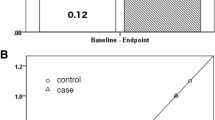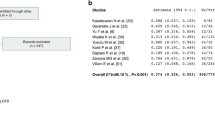Abstract
Purpose
To evaluate the clinical characteristics of strabismus in children undergoing bilateral cataract surgery.
Methods
We retrospectively reviewed the medical records of 56 children undergoing bilateral cataract surgery who had no evidence of strabismus before the surgery and a difference of less than two Snellen lines in postoperative best-corrected visual acuity between the two eyes.
Results
Strabismus developed in 31 (55.4%) patients after cataract extraction. Age at the time of cataract diagnosis (P = 0.006) and extraction (P = 0.025) was significantly lower in the strabismus group than in the no-strabismus group. Exotropia (45.2%) was the prevalent type of strabismus, followed by esotropia (35.5%). Patients with cataracts extracted within the first 12 months of life comprised 51.6% of the strabismus group and 20% of the no-strabismus group (P = 0.026). Strabismus surgery was performed in 11 patients. In five aphakic patients with strabismus, the angle of deviation decreased significantly after secondary intraocular lens implantation, and strabismus surgery was not required.
Conclusion
Strabismus is a frequent complication following bilateral cataract surgery in childhood. Children undergoing bilateral cataract surgery, especially at an early age, should be followed carefully for the development of strabismus.
Similar content being viewed by others
References
Lambert SR, Lynn M, Drews-Botsch C, et al. A comparison of grating visual acuity, strabismus, and reoperation outcomes among children with aphakia and pseudophakia after unilateral cataract surgery during the first six months of life. J AAPOS 2001;5:7–75.
Awner S, Buckley EG, DeVaro JM, Seaber JH. Unilateral pseudophakia in children under 4 years. J Pediatr Ophthalmol Strabismus 1996;33:230–236.
Merino P, Gómez-de-Liaño P, Gil MR, et al. Strabismus and congenital cataracts. Arch Soc Esp Oftalmol 2007;82:623–628.
France TD, Frank JW. The association of strabismus and aphakia in children. J Pediatr Ophthalmol Strabismus 1984;21:223–226.
Weisberg OL, Sprunger DT, Plager DA, Neely DE, Sondhi N. Strabismus in pediatric pseudophakia. Ophthalmology 2005;112:1625–1628.
Lundvall A, Kugelberg U. Outcome after treatment of congenital bilateral cataract. Acta Ophthalmol Scand 2002;80:593–597.
Yamamoto M, Dogru M, Nakamura M, et al. Visual function following congenital cataract surgery. Jpn J Ophthalmol 1998;42:411–416.
Lambert SR, Drack AV. Infantile cataracts. Surv Ophthalmol 1996;40:427–458.
Fallaha N, Lambert SR. Pediatric cataracts. Ophthalmol Clin North Am 2001;14:479–492.
Egbert JE, Fantin A. Factors influencing measurement and response to strabismus surgery. In: Rosenbaum AL, Santiago AP, editors. Clinical strabismus management, principles and surgical techniques. Philadelphia: Saunders; 1999. p. 73–83.
Hubel DH, Wiesel TN. The period of susceptibility to the physiologic effects of unilateral eye closure in kittens. J Physiol 1970;206:419–436.
Dharmaraj S, Azar N. Controversies of implanting intraocular lenses in infancy. Int Ophthalmol Clin 2006;45:61–81.
Archer SM, Sondhi N, Helveston EM. Strabismus in infancy. Ophthalmology 1989;96:133–137.
Birch EE, Shimojo S, Held R. Preferential-looking assessment of fusion and stereopsis in infants aged 1–6 months. Invest Ophthalmol Vis Sci 1985;26:366–370.
Mohindra I, Zwaan J, Held R, Brill S, Zwaan F. Development of acuity and stereopsis in infants with esotropia. Ophthalmology 1985;92:691–697.
Lesueur LC, Arné JL, Chapotot EC, Thouvenin D, Malecaze F. Visual outcome after paediatric cataract surgery: is age a major factor? Br J Ophthalmol 1998;82:1022–1025.
Watts P, Abdolell M, Levin AV. Complications in infants undergoing surgery for congenital cataract in the first 12 weeks of life: is early surgery better? J AAPOS 2003;7:81–85.
Ye HH, Deng DM, Lin Z, Chen WR. Long-term visual outcome of dense bilateral congenital cataract. Chin Med J 2007;120:1494–1497.
Kim SH, Plager DA. Stereopsis in children with unilateral pseudophakia. Br J Ophthalmol 2009;93:333–336.
Pratt-Johnson JA, Tillson G. Unilateral congenital cataract: binocular status after treatment. J Pediatr Ophthalmol Strabismus 1989;26:72–75.
Hiles DA, Sheridan SJ. Strabismus associated with infantile cataract. Int Ophthalmol Clin 1977;17:193–202.
Author information
Authors and Affiliations
Corresponding author
About this article
Cite this article
Park, S.H., Na, J.H. & Shin, S.Y. Strabismus following bilateral cataract surgery in childhood. Jpn J Ophthalmol 54, 272–277 (2010). https://doi.org/10.1007/s10384-010-0806-0
Received:
Accepted:
Published:
Issue Date:
DOI: https://doi.org/10.1007/s10384-010-0806-0




